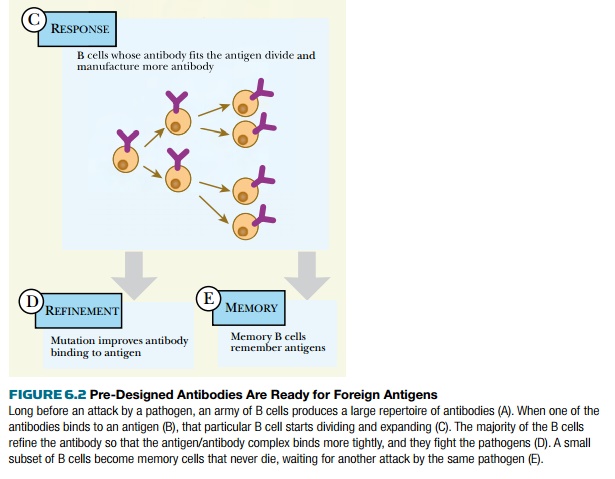Chapter: Biotechnology Applying the Genetic Revolution: Immune Technology
Antibody Structure and Function
ANTIBODY
STRUCTURE AND FUNCTION
The world is full of
infectious microorganisms, all looking for a suitable host to infect. Bacteria,
viruses, and protozoans are constantly attempting to gain entry into our
tissues. If nothing was done about these attempts at invasion, no human could
survive. Fortunately, cells of the immune system patrol the internal tissues,
the bloodstream, and the body surfaces, both outside and inside, protecting the
entire organism from attack. Any foreign macromolecules that are not recognized
as being “self” will be regarded as signs of an intrusion and will trigger an
immune response. Invading microorganisms have their own distinctive proteins,
which differ in sequence and therefore in 3-D structure from those of the host
animal. In particular, those molecules exposed on the surfaces of invading
microorganisms will attract the attention of the immune system. These foreign
molecules are referred to as antigens,
and the immune system molecules that recognize and bind to them are known as antibodies (Fig. 6.1).

Although we often speak as if
the body makes antibodies in response to invasion by a foreign antigen, this is
rather misleading. In fact, long before infection, the immune system generates
billions of different antibodies. Each B
cell of the immune system has the capability to make just one of these. The
immune system keeps a few B cells on standby for each of its colossal
repertoire of antibodies. This happens before encountering the antigens and
without knowing which antibodies will actually be needed later. If enough
different antibodies are available, at least one or two should match an antigen
of any conceivable shape, even if the body has never come into contact with it
before.


Eventually, a foreign antigen
appears (Fig. 6.2). Among the billions of predesigned antibodies, at least one
or two will fit the antigen reasonably well. Those B cells that make antibodies
that recognize the antigen now divide rapidly and go into mass production. Thus
the antigen determines which antibody is amplified and produced. Once a
matching antibody has bound invading antigens, the immune system brings other
mechanisms into play to destroy the invaders.
Sometime later there is a
stage of refinement during which those antibodies that bound to the invading
antigen are modified by mutation to fit the antigen better. In addition, the
immune system keeps a record of antibodies that are actually used. If the same
invader ever returns, the corresponding antibodies can be rushed into action,
faster and in greater numbers than before. Vaccines exploit this capacity by
stimulating the immune system to store the antibodies that recognize and
destroy a pathogenic virus such as smallpox. Yet the vaccines cause no disease
symptoms themselves (see later discussion).
Related Topics